Taurus Void
| Observation Data | |
|---|---|
| (Epoch J2000[1]) | |
| Right Ascension | 3h30min[1] |
| Declination | +20°[1] |
| Galactic Longitude | 167°[2] |
| Galactic Latitude | -29°[2] |
| Apparent Radial Velocity | 4000km/s[2] |
| Radius | ~2000km/s[2] |
The Taurus Void is a vast, near empty region of space situated between the Perseus-Pisces Supercluster and the Virgo Supercluster. The Taurus void is unique because of its relatively close proximity to Earth, and because it helps to define the edge of latter's home supercluster, the Virgo supercluster. Despite its close proximity to Earth, the Taurus Void is not well studied because it is partially obscured by the Milky Way when viewed from Earth. In contrast to its ambiguous boundary in the section of sky obscured by the Milky Way, the Taurus Void has a very well defined boundary with the Perseus-Pisces supercluster.[3]
Location
In Earth’s sky, the Taurus Void appears from ~2h40min to at least 4h ra, at which point it is obscured by the Milky Way, and from 5° to 40° dec.[4] Opposite its border with the Milky Way, the Taurus Void forms a distinct border with the Perseus-Pisces supercluster. Specifically, the void is bordered by the galaxy clusters A400, A426, and A374 within the supercluster.[5]
In 3D space, the Taurus Void resides between the Perseus-Pisces supercluster and our own Virgo supercluster. By situating itself between these two superclusters, the Taurus Void, along with the Local Void, define the boundary between these two superclusters (and to some extent the Laniakea Supercluster, because the Virgo supercluster is technically a part of the much larger Laniakea supercluster).[6]
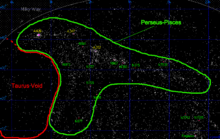 As seen from Earth: The Taurus Void lies immediately adjacent to the Perseus-Pisces supercluster. The dashed line represents the uncertain boundary due to obstruction from the Milky Way. |
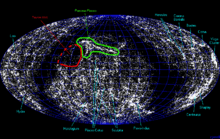 As seen from Earth: A full sky map of the 60,000 brightest galaxies, with the Taurus Void circled in red, and the Perseus-Pisces supercluster circled in green. The large, dark, circular band crossing the image is the plane of the Milky Way, whose gas, dust, and stars obscure distant galaxies. The dashed red line represents the uncertain boundary of the void where extinction due to the Milky Way blocks the view from Earth. |
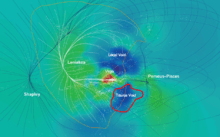 As seen from a third person view in space: The Taurus Void, circled in red, lies between the Perseus-Pisces supercluster and the Virgo and Laniakea superclusters. In the previous two pictures, the images were taken from within the Virgo supercluster, looking toward the Taurus Void and the Perseus-Pisces supercluster. |
Zone of Avoidance
Despite its close proximity to Earth, the Taurus Void is a difficult void to study because it lies behind the Zone of Avoidance (ZOA)- the area of sky obscured by the Milky Way. It can be seen in the following images, that the Taurus Void lies behind an area of high extinction.[5]
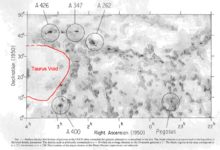 This image shows the average density of galaxies Perseus-Pisces supercluster. The Taurus Void is circled in red. |
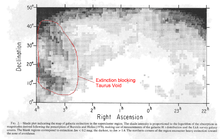 This image shows the magnitude of light extinction due to the Milky Way and other foreground bodies. Circled in red is the “extinction arm” that blocks much of the Taurus Void. |
Due to the fact that much of the Taurus Void lies behind an area of high extinction, scientists face a challenge when trying to determine the density and dimensions of the Taurus Void. The main problem is that light from dimmer galaxies lying behind the Milky Way may be extinguished before it reaches Earth, preventing scientists from observing these galaxies. This would lead scientists to believe that the Taurus Void is emptier than it actually is, because they can’t observe the galaxies that may be present.
This is not to say that the Taurus Void isn’t an actual void however. The void has previously been observed in the infrared spectrum (where there is less foreground extinction from the Milky Way) to establish that the void is indeed a void.[7] Additionally, there have been other studies that have mapped the void[5][6][7][8] and others that have determined the rate of galaxy outflow from the void to other superclusters.[9] Together, these studies provide strong evidence that a void does exist, despite the difficulty of observing objects behind the ZOA.
Further efforts to see behind the Milky Way’s ZOA such as the ALFAZOA[10] and ALFALFA[11] surveys may be able to perform more accurate measurements and place better constraints on the parameters of the void in the future. The surveys, conducted using the Arecibo radio telescope, will attempt to look for light from distant galaxies that has been redshifted to a wavelength that will stand out in comparison to the noise caused by the Milky Way’s Zone of Avoidance. However, these surveys have limited range in the north-south (declination) direction, due to operation constraints of the Arecibo telescope.
See also
References
- 1 2 3 Henning, P. A. et. al. "The Arecibo L-band Feed Array Zone of Avoidance Survey. I. Precursor Observations Through the Inner and Outer Galaxy." The Astronomical Journal, June 2010.
- 1 2 3 4 Donley, J. L. et. al. "The H I Parkes Zone of Avoidance Survey: The Northern Extension." The Astronomical Journal, Jan. 2005, original data from Fairall, A. P. 1998, Large-Scale Structures in the Local Universe (Chichester: Wiley)
- ↑ Powell, Richard. "The Perseus-Pisces Supercluster." Atlas of the Universe. Web. Retrieved 18 Oct. 2015.
- ↑ Haynes, Martha P., and Riccardo Giovanelli. "A Survey of the Pisces-Perseus Supercluster V. the Declination Strip +33.5 to +39.5 and the Main Supercluster Ridge." The Astronomical Journal, 18 Nov. 1992.
- 1 2 3 Giovanelli, Riccardo; Haynes, Martha P.; Chincarini, Guido L. (1986). "Morphological Segregation in the Pisces-Perseus Supercluster" (PDF). The Astrophysical Journal. Bibcode:1986ApJ...300...77G.
- 1 2 Tully, R. Brent; et al. "The Laniakea Supercluster of Galaxies". Nature. 513.
- 1 2 Lu, Nanyao Y., and W. Freudling. "Large-Scale Structures in the Highly Obscured Orion-Taurus Region" SAO/NASA Astrophysics Data System. Harvard-Smithsonian Center for Astrophysics, 1994.
- ↑ Marzke, Ronald O., Huchra, John P., and Geller, Margaret J. "Large-Scale Structure at Low Galactic Latitude" SAO/NASA Astrophysics Data System. Harvard-Smithsonian Center for Astrophysics, November 1996.
- ↑ Erdoǧdu, Pirin et. al. "Reconstructed density and velocity fields from the 2MASS Redshift Survey" SAO/NASA Astrophysics Data System. Harvard-Smithsonian Center for Astrophysics, Aug. 30, 2006.
- ↑ ALFA ZOA Team. "The Arecibo Zone of Avoidance Survey (ALFAZOA)." Arecibo Observatory, 5 Oct. 2015. Web. Retrieved 18 Oct. 2015.
- ↑ ALFA Team at Cornell. "The Arecibo Legacy Fast ALFA Survey." Arecibo Observatory, 1 Apr. 2013 Web. Retrieved 18 Oct. 2015.
External links
- Atlas of the universe page on the Perseus-Pisces Supercluster and Taurus Void
- Atlas of the universe page on The Universe within 1 billion Light Years and The Neighboring Superclusters